The U.S. Institute of Peace interviewed Dr. Kenneth Katzman, a former CIA analyst, who is now an Iran expert at the Congressional Research Service (CRS). His responses are made in his personal capacity, not for CRS or the Library of Congress.
Ebrahim Raisi, a hardliner, has now been in power for one year. What are the major differences from his predecessor Hassan Rouhani, a centrist?
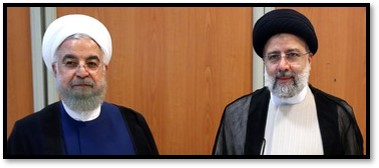
Raisi has long expressed hardline views on both domestic and foreign policy. The United States sanctioned him in 2019, citing his role in domestic repression. Raisi is best known for serving on the so-called “death commission” that ordered the extrajudicial executions of thousands of political prisoners in 1988. Raisi was critical of Rouhani in both his failed 2017 presidential campaign and his successful 2021 campaign.
Raisi, like all presidents, replaced the ministers of his predecessor. Rouhani’s cabinet included several ministers who were educated in the West or were open to engagement with the West. In contrast, Raisi’s team was largely educated in Iran and has favored boosting ties with Asian powers. Five of his ministers were designated under U.S. sanctions.
The change in foreign ministers was a microcosm for the transition. Rouhani’s foreign minister, Mohammad Javad Zarif, spoke fluent English after receiving a B.A. and an M.A. from San Francisco State University, and an M.A. and PhD in international relations from the University of Denver. Zarif also served in New York as Iran’s ambassador to the United Nations from 2002 to 2007. As foreign minister (2013-2021), he played a key role in negotiating the 2015 nuclear deal and developed a working relationship with Secretary of State John Kerry.

By contrast, Raisi’s foreign minister, Hossein Amir-Abdollahian, speaks fluent Arabic and stilted English. He received a PhD in international relations from the University of Tehran. During his career at the foreign ministry, he was posted to Iraq and Bahrain and had portfolios largely focused on the region. As foreign minister, his priorities are to improve relations with Iran’s neighbors as well as Asian countries. Amir-Abdollahian reportedly has close ties to the Islamic Revolutionary Guard Corps (IRGC).
The change in president and ministers, however, has not translated into much of a shift. Raisi has generally continued down the same path as Rouhani on domestic and foreign policy.
How has the Raisi government handled the economy?
The deck was stacked against Raisi when he came into office. Iran has been under extensive U.S. sanctions since the Trump administration withdrew from the nuclear deal in 2018 and launched its “maximum pressure” campaign. Raisi also inherited an economy rife with corruption, nepotism and inefficiency. Like his predecessors, he has pledged to tackle inflation, corruption and tax evasion, but has made limited progress. In May-June 2022, food prices were up more than 80 percent compared to the same period in 2021, according to official figures.
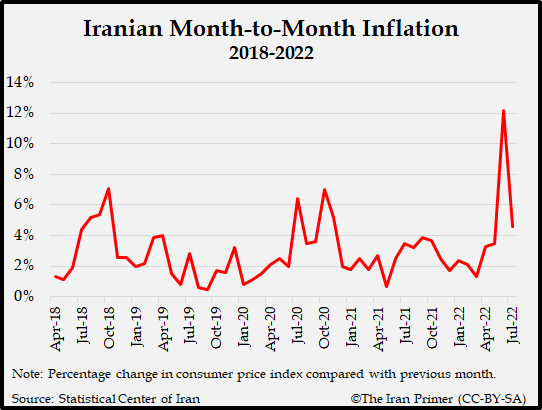 Raisi set a target of eight percent growth in his budget for the Iranian year that began in March 2022. The International Monetary Fund, however, has projected only three percent growth.
Raisi set a target of eight percent growth in his budget for the Iranian year that began in March 2022. The International Monetary Fund, however, has projected only three percent growth.
Raisi has limited options to boost trade or foreign investment because very few countries or businesses are willing to defy U.S. sanctions. The U.S. economy is a behemoth with a GDP of $23 trillion. Iran’s GDP is about $250 billion. Most countries and businesses do not want to risk getting cut off from the much larger U.S. market for the limited opportunities in doing business with Tehran. China has been willing to buy a lot of Iranian oil, but that’s the main notable exception.
How has the government dealt with the sporadic protests over soaring prices, unpaid salaries, low pensions, and corruption?
The Raisi government has responded in much the same way as the Rouhani government. Officials have acknowledged the right of citizens to protest but have also made clear that they will not allow demonstrations to burn too hot. Security forces have used deadly force to disperse protests.
In May 2022, protests erupted across several provinces in response to subsidy cuts that led to a spike in prices of food staples. At least five people reportedly died in clashes with security forces, and dozens were arrested.
What impact has Raisi had on Iran’s foreign policy? What have been his priorities—and how have they either been the same or differed from the Rouhani government. What has he done or achieved?
Raisi has been relatively cautious and has not changed the overall direction of foreign policy. In Iran’s system, the president can guide foreign policy, but he is only one of several players at the Supreme National Security Council, the most powerful body for setting national security policy. Raisi has little reason to rock the boat or take major risks because Iran’s position in the region is relatively strong. It has sponsored armed proxies and political allies in Iraq, Lebanon, Syria, and Yemen that help project power and influence across the region.
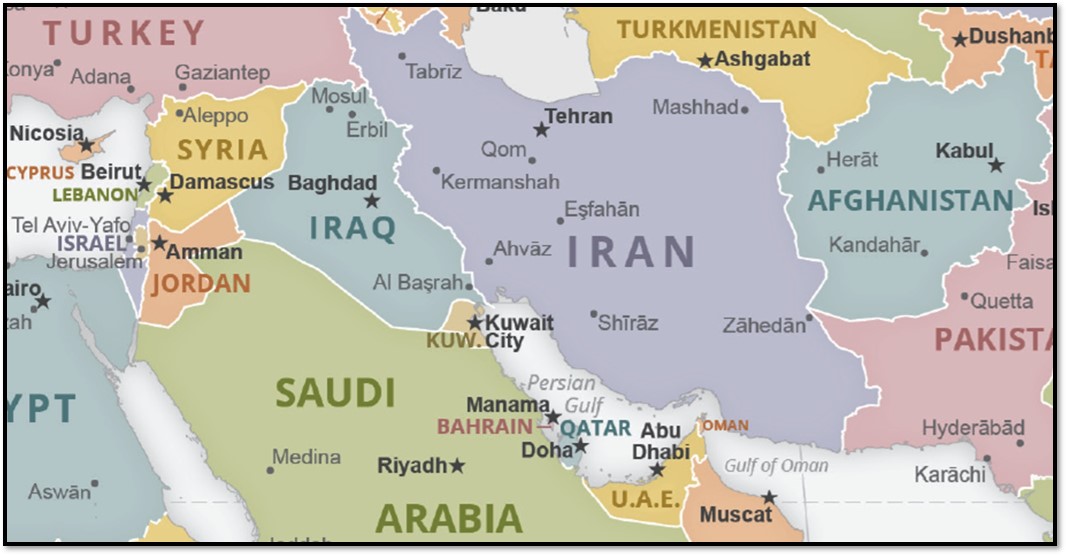 Raisi’s priorities have been easing tensions with Iran’s neighbors and boosting ties with Asian powers, especially China and Russia. Raisi has also focused on expanding Iran’s trade with Central Asian countries, perhaps thinking they may not strictly abide by U.S. sanctions. He has been active on the diplomatic front. As of July 2022, he had traveled to Oman, Qatar, Russia, Tajikistan, and Turkmenistan (twice). Raisi’s first trip was to Tajikistan, where he participated in the Shanghai Cooperation Organization summit in September 2021. The regional economic and security bloc, led by China and Russia, accepted Iran’s bid for membership 15 years after it applied.
Raisi’s priorities have been easing tensions with Iran’s neighbors and boosting ties with Asian powers, especially China and Russia. Raisi has also focused on expanding Iran’s trade with Central Asian countries, perhaps thinking they may not strictly abide by U.S. sanctions. He has been active on the diplomatic front. As of July 2022, he had traveled to Oman, Qatar, Russia, Tajikistan, and Turkmenistan (twice). Raisi’s first trip was to Tajikistan, where he participated in the Shanghai Cooperation Organization summit in September 2021. The regional economic and security bloc, led by China and Russia, accepted Iran’s bid for membership 15 years after it applied.
Afghanistan: Raisi took office in August 2021 as the Taliban took over wide swaths of Afghanistan, which shares a 572-mile border with Iran. Raisi welcomed the departure of U.S. forces but cautiously engaged with the Taliban. Iran had supported opposition forces against the Taliban when it last ruled the country from 1996 to 2001. Raisi has repeatedly called for an inclusive government that includes all political factions and reflects Afghanistan’s religious and ethnic diversity. Tensions have flared over sporadic altercations at border crossings.
China: Under Raisi, Iran has increased oil exports to China. In January 2022, Iran reportedly exported more than 700,000 barrels per day – more than Iran exported before the reimposition of U.S. sanctions in 2018. China has also continued to invest in a broad range of Iranian industries, including oil and gas, lumber, and light manufacturing. But this pattern began years ago.
Iraq: In August 2021, Foreign Minister Amir-Abdollahian participated in a regional conference in Baghdad along with presidents, kings or foreign ministers from Egypt, Jordan, Kuwait, Qatar, Saudi Arabia, Turkey, and the United Arab Emirates. French President Emmanuel Macron also participated. The goal was to ease regional tensions. Iran continues to support an array of Shiite militias and political parties, which may be in a position to form a government more to their liking.
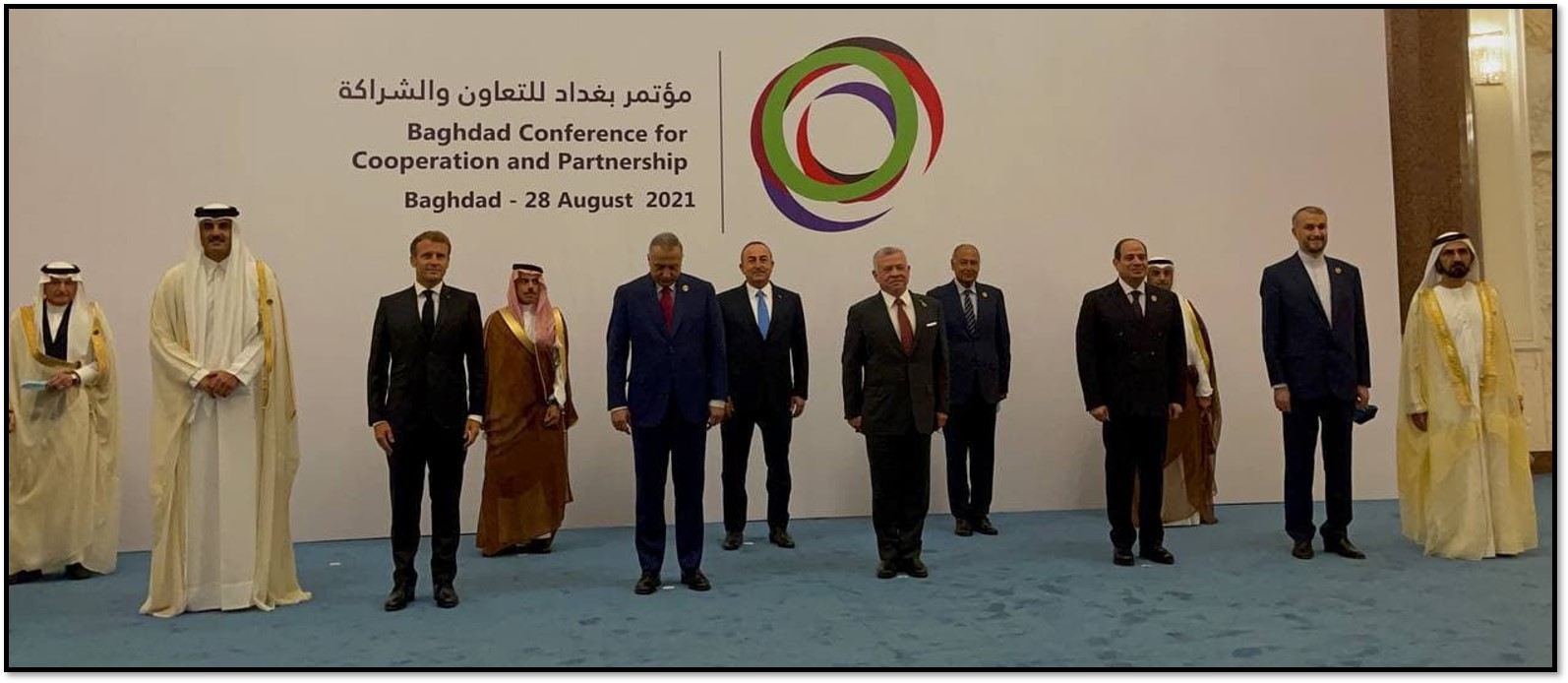
Israel: Since Raisi took office, Israel has allegedly carried out several operations, including two drone strikes and an assassination, in Iran. But Iran’s responses have been surprisingly muted. In March 2022, Iran fired a dozen ballistic missiles into Iraqi Kurdistan. The IRGC claimed that it targeted Israeli “strategic centers” in Erbil. The only other notable retaliation appeared to be a plot to assassinate Israeli tourists in Istanbul that was foiled by Turkish authorities and Israel’s Mossad in June 2022. But those moves were relatively small compared to the alleged Iranian strike on Saudi Arabian oil facilities in 2019 or sabotage of Gulf shipping that occurred during Rouhani’s presidency.
Lebanon: Iran continues to provide weapons, including missiles and drones, and funding to Hezbollah, the Shiite political party and militia. Hezbollah has evolved into the strongest armed group in Lebanon and one of the most influential political players.
Oman: In May 2022, Raisi visited Muscat to sign deals for expanded cooperation on energy, transportation, education, and trade.
Qatar: Raisi signed agreements on transportation, trade, tourism, energy, and education during a visit to Doha in February 2022. Emir Tamim bin Hamad al Thani visited Tehran to discuss ways to boost bilateral ties in May 2022. They also discussed diplomatic efforts to restore the 2015 nuclear deal.

Russia: In perhaps the most significant change, Iran has accelerated the expansion of ties to Russia despite the invasion of Ukraine, which has led to extensive Western sanctions on Russia and made President Vladimir Putin “radioactive” around the world. Raisi met Putin three times in the first seven months of 2022 alone. When Putin visited Tehran in July, Supreme Leader Ayatollah Ali Khamenei endorsed Russia’s invasion of Ukraine. “If you had not taken the helm, the other side [NATO] would have done so and initiated a war,” he told Putin. Russia has also shown an interest in purchasing Iranian drones, according to the White House. On energy, the two countries have cooperated as part of OPEC+ to try to keep oil prices high. But Russia has also started to heavily discount its oil to sell to China, putting it in competition with Iran.
Saudi Arabia: Iran has continued a series of talks that began in April 2021 to restore diplomatic relations, which were severed in 2016. In July 2022, Iran announced its readiness to move talks to the political level. Iraq mediated the talks.
Syria: Iran continued to bolster the Assad regime, which has regained much territory from rebel and jihadi groups since the civil war broke out in 2011.
United Arab Emirates (UAE): Foreign Minister Amir-Abdollahian made a rare visit to Abu Dhabi to pay respects following the death of President Sheikh Khalifa in May 2022. He said that the two countries were turning a “new page” after years of tensions. As of July, the UAE was considering sending an ambassador back to Tehran. The UAE had downgraded its ties with Iran in 2016.
Yemen: Iran continued to provide weapons to the Houthi rebels. But it also welcomed the U.N.-brokered ceasefire between the Houthis and Yemeni government that began in April 2022 and has subsequently been renewed.
In his first year, what has the Raisi government done on the 2015 nuclear deal? How has his position continued or differed from the Rouhani government?
Rouhani appeared more willing than Raisi to compromise with the United States to restore the 2015 nuclear deal, known as the Joint Comprehensive Plan of Action (JCPOA). Indirect talks between the six major world powers and Iran started in the last months of Rouhani’s presidency, in April 2021. The negotiations paused just after Iran’s presidential election in June. Raisi took office in August, but his government conducted an internal review of the negotiations that took some three months. Raisi picked Ali Bagheri Kani, a career diplomat who had long criticized the JCPOA, to head the negotiating team. Talks finally resumed in late November 2021, but U.S. and European diplomats expressed frustration that Iran’s new team backtracked on earlier commitments and demanded more concessions on U.S. sanctions.
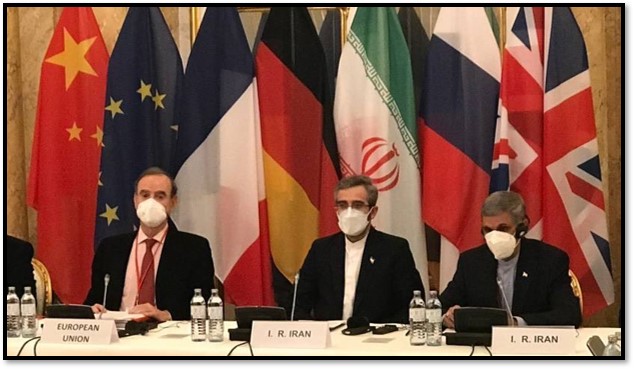
Raisi has been more skeptical about the deal’s durability and benefits. He is closer to Supreme Leader Ayatollah Ali Khamenei, who has always had doubts about the JCPOA and distrusts the United States. Even before the United States withdrew from the deal in 2018, officials complained that Iran was not adequately benefitting from the deal because it was still barred from the U.S. financial system.
Raisi may also see the restoration of the nuclear deal as less urgent than his predecessor. The political clock in Washington, namely the potential outcome of the 2024 presidential election, may play into Iran’s calculus. Raisi’s negotiating team has demanded a guarantee that a future U.S. president will not withdraw from the deal again. But Biden cannot provide that assurance without ratifying the JCPOA as a treaty in the Senate. Meanwhile, many lawmakers– including potential presidential candidates – have opposed Biden’s efforts to revive the JCPOA. So Iranian leaders may assess that sanctions relief, as part of a restored deal, could end as early as January 2025 when a new U.S. president takes office.
Furthermore, Iran could need six or eight months to dismantle parts of its nuclear program to come back into full compliance with the deal. By the time the United States lifts sanctions, Iran could have a window of less than two years of sanctions relief, maybe 18 months or less depending on the timing. And while negotiations are stalled, time is shrinking.
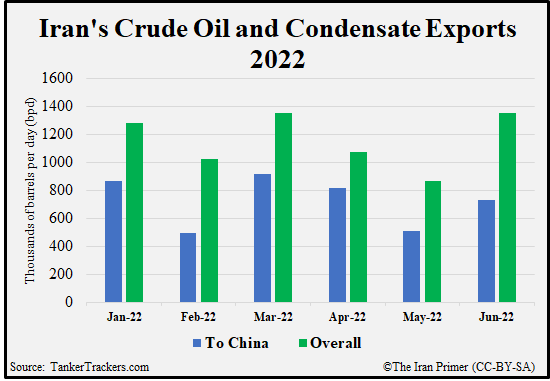 Raisi and his advisors may also calculate that Iran’s economy can get along under U.S. sanctions. Iran has managed to increase oil sales to China. Even though Iran sells oil at a discount, it has benefitted from high global prices in 2022. On July 26, the economy minister boasted that revenue from oil and condensate exports was 580 percent higher from March 21 to July 21 compared with the same period in 2021. The potential benefits of short-term sanctions relief may not be very enticing for Tehran.
Raisi and his advisors may also calculate that Iran’s economy can get along under U.S. sanctions. Iran has managed to increase oil sales to China. Even though Iran sells oil at a discount, it has benefitted from high global prices in 2022. On July 26, the economy minister boasted that revenue from oil and condensate exports was 580 percent higher from March 21 to July 21 compared with the same period in 2021. The potential benefits of short-term sanctions relief may not be very enticing for Tehran.
Raisi is not as keen on bolstering economic ties with Western countries compared to Rouhani. Rouhani visited Europe twice during his tenure, and he tried to push through reforms to Iran’s business environment to help attract foreign investment. In contrast, Raisi has pledged not to tie the economy to “the will of foreigners.” Some members of his economic team subscribe to the “resistance economy” model, which prioritizes self-sufficiency to neutralize the impact of sanctions.
But Iran’s hesitation over restoring the JCPOA may well be due more to changing circumstances than changes in leadership.
What have been the Raisi government’s priorities on security and on military advances? How have they differed from the Rouhani government?

Again, the policy has been mostly a continuation. Iran lacks modern warplanes. It still flies vintage models procured under the monarchy. So it has expanded its airpower with much cheaper missiles and drones. Iran had some 3,000 ballistic missiles in its arsenal as of March 2022, according to General Kenneth McKenzie, the head of U.S. Central Command at the time. It has focused on improving the accuracy and increasing payload of solid fuel missiles, which can be easily transported and launched at short notice. Iran has developed a diverse fleet of drones that can perform reconnaissance as well as attack functions.
Iran is increasingly eager to export arms. In May 2022, Iran opened a drone factory in Tajikistan. Russian officials reportedly visited Iran at least twice in June/July 2022 to see the Shahed-191 and Shahed-129 drones. The Shahed-191 was based on a captured U.S. RQ-170 Sentinel, and the Shahed-129 was based on a captured U.S. MQ-1 Predator.
How has his government handled the Covid pandemic?
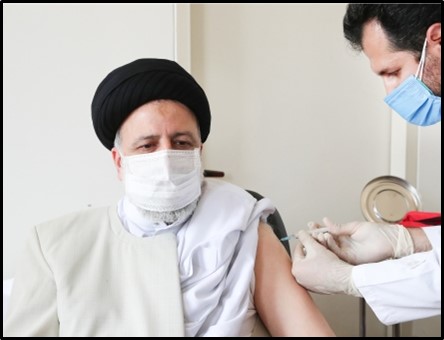
Raisi took office in August 2021 amid a fifth wave of infections. Only three percent of Iran’s population was fully vaccinated at the time. In his first month in office, the government curtailed travel and traffic, and imposed a six-day lockdown to stem the spread of the highly infectious Delta variant. But the government relaxed restrictions as it rolled out vaccines, largely supplied by China. By mid-July 2022, 66 percent of Iranians were fully vaccinated. But Raisi was not directly responsible for the approach to the pandemic. Iran’s healthcare system is one of the better systems in the region.
